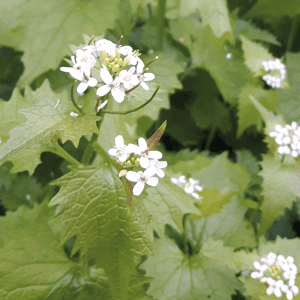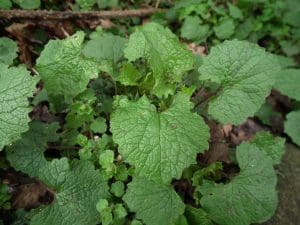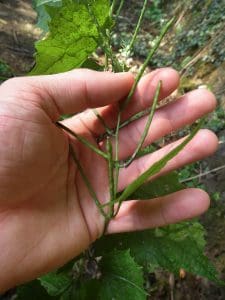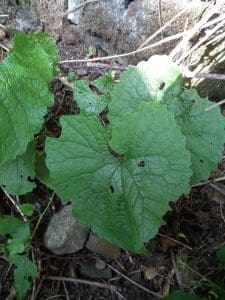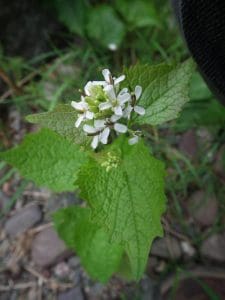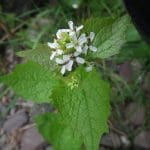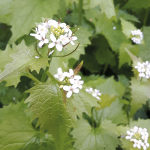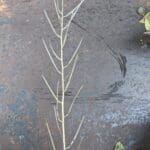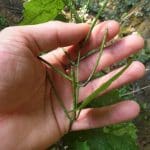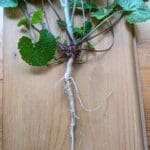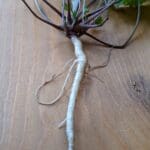Garlic Mustard / Spring / Summer / Autumn / Edible
Garlic Mustard, Hedge Garlic or Jack by the Hedge, whatever you call it, this edible wild green is a spicy mustard and garlic delight!
Common names
Hedge garlic, Jack-by-the-Hedge, Garlic Mustard, Poor Man’s Mustard, Garlic Root, Penny Hedge, Sauce Alone
Botanical name
Alliaria petiolata
Scientific Classification
Kingdom – Plantae
Order –Brassicales
Family –Brassicaceae
Physical characteristics for Garlic Mustard
Leaves
Hedge garlic is a biennial plant. In its first year, it has kidney-shaped toothed leaves. The leaves have a mild garlic odour when they are crushed.
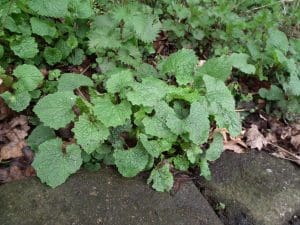
In its second year, the leaves become more heart-shaped and pointed but remain toothed.
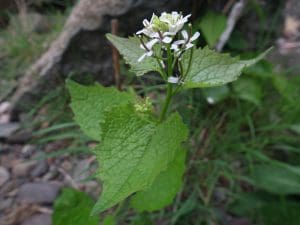
Flowers
It throws up a flower stalk with a cluster of white four-petalled flowers at the top.
Seeds
It has long thin seed pods, very standard for plants within the Mustard family, when squeezed you can feel small seeds are held within the pod.
Root
The plant has a deep taproot that is tan in colour and has a horseradish-like scent.
Habitat
Hedgerows, woodland edges, around fence posts, gateways, in fact anywhere where it can get a bit of support
Known hazards
People who suffer from hypothyroidism are advised against excessive consumption of members of the Brassica or Mustard family. Hedge garlic is a Brassica.
Could be confused with
Honesty (Lunaria annua), before either is in flower, but this is also edible. After flowering, Honesty has purple flowers, whereas Hedge Garlic has white flowers (it’s also edible)
Ground Ivy is much smaller and grows from a stem that crawls over the ground (it’s also edible)
Lesser Celandine has a much more dark and waxy leaf and produces yellow flower (it’s edible in spring before producing its flower)
Garlic Mustard Foraging Video
Edible use
The leaves and flowers can be used raw in salads, or lightly steamed. Some people get a strong unpleasant taste on chewing the leaves, however, a good dressing usually solves that.
After Hedge Garlic has flowered, the seeds can be used as a mustard-flavoured spice or seasoning. They can also be used to make a rustic wholegrain mustard.
The roots have a great Horseradish like flavour and can be added to salad dressings or marinades. You can also slice the roots thinly and infuse them into vinegar or oils
Notes on Herbal uses
Hedge garlic contains mustard oil glycosides and has been used in the treatment of asthma, eczema, and skin irritation. Chewing the leaves is believed to relieve mouth ulcers. If you have a medical complaint, please visit your doctor.
Extra notes from the Foragers
When it comes to the common names of plants, “Jack” is often used as a term of reference for the Devil – Devil-by-the-Hedge.
This plant has very few natural consumers. Two species of weevil are being considered as a possible control method in the USA, where it is classed as a non-native invasive. Hedge garlic is believed to have anti-bacterial and anti-fungal properties, meaning it is resistant to biological attack in the soil.
The leaves contain a small amount of cyanide, not enough to damage a human, but enough to kill insects that may attempt to eat it.
The first part of the name, Alliaria, means “resembling an Allium”, which is reference to its garlic-like scent. Petiolata means “with a leaf stalk”



